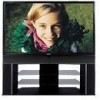Toshiba 62MX196 Operating Guide - Page 110
Connecting a personal computer
 |
UPC - 022265251560
View all Toshiba 62MX196 manuals
Add to My Manuals
Save this manual to your list of manuals |
Page 110 highlights
Connecting your TV Connecting a personal computer (PC) This connection allows you to view the image from a PC on the TV screen. When connecting a PC to the TV, use an analog RGB (15-pin) computer cable and a PC audio cable. TV Computer PC audio output PC audio cable Conversion adapter (if necessary) • To use a PC, set the monitor output resolution on the PC before connecting it to the TV. The following signals can be displayed: - VGA: 640 5 480 @ 60Hz - SVGA: 800 5 600 @ 60Hz - XGA: 1024 5 768 @ 60Hz Other formats or non-standard signals may not be displayed correctly. • To display the optimum picture, use the PC setting feature (- "Using the PC setting feature" in the Operating Guide). Signal names for mini D-sub 15-pin connector Pin assignment for RGB/PC terminal 5 1 10 6 15 11 Pin No. 1 2 3 4 5 6 7 8 9 10 11 12 13 14 15 Signal name R G B NC (not connected) NC Ground Ground Ground NC Ground NC NC H-sync V-sync NC Notes: • Some PC models cannot be connected to this TV. • An adapter is not needed for computers with a DOS/V compatible mini D-sub15-pin terminal. • Depending on the DVD's title and the specifications of the PC on which you are playing the DVD-Video, some scenes may be skipped or you may not be able to pause during multi-angle scenes. • Only models that include a PC IN (VGA) port are suitable for connecting a PC. Never connect a PC to the HDMI port. 18















